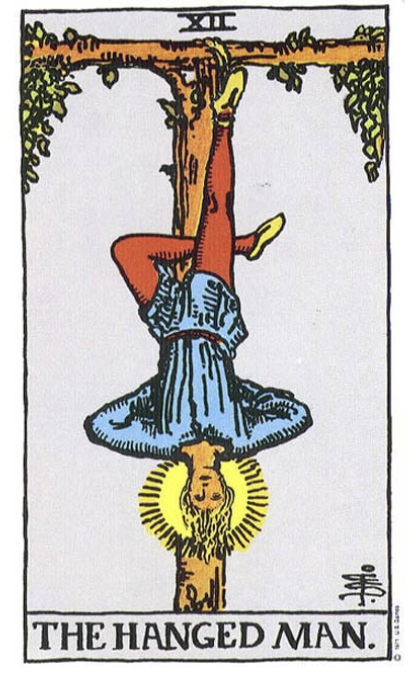The Hanged Man – Suspension and Sacred Surrender
The Hanged Man, numbered XII in the Major Arcana, is the turning point between the first and second halves of the Fool’s Journey. It is a card of surrender, stillness, and spiritual inversion. When it appears, it signals that something in our lives is undergoing a profound inner shift. Yet, unlike the Tower or Death cards, which bring active change, The Hanged Man requires us to pause and yield to a higher wisdom. This is not a time for movement. It is a time for metamorphosis.
The traditional image of The Hanged Man shows a figure suspended upside down from a tree by one foot. His hands are often tied behind his back, his free leg bent into a cross, and a golden halo surrounds his head. Far from a scene of suffering, the image evokes serenity. He is not being punished. He has chosen this position, and from it, he sees the world differently.
This is the archetype of liminality—the space between no longer and not yet. It is in this in-between that sacred transformation occurs. It is a paradox: we find freedom in the suspension, and wisdom in the waiting.
Personal Reflection: Healing in the In-Between
Whenever The Hanged Man appears in my life, I know I am being asked to surrender. But not just let go. Truly surrender. I think of the months I spent recovering from mold and parasite toxicity—an invisible illness that disrupted everything. I couldn’t work like I used to. I couldn’t go out. I wasn’t strong enough to date or socialize. But I was also no longer who I had been. It was a time of stillness, solitude, and deep internal change.
I remember feeling the strange tension of healing without being healed. Of knowing things would never be the same, but also not knowing what they would become. This was the Hanged Man’s realm: no movement, only perspective. No answers, only the quiet rearrangement of my soul.
I wrote about these moments in both Cherry Pie and Enlightenment Pie. The experience of illness became a kind of initiation. I had to learn how to be in the not-knowing. I had to stop grasping for the next chapter and allow myself to fully inhabit the space between.
That was the gift of The Hanged Man.
The Deep Symbolism of The Hanged Man
The Hanged Man is often associated with the Norse god Odin, who hung himself from Yggdrasil, the World Tree, for nine days in order to receive the wisdom of the runes. It is also linked to the archetype of the sacrificial god: one who gives of himself for the sake of spiritual knowledge.
In the Rider-Waite deck, we find layers of esoteric meaning:
The Inverted Posture: In yoga, inversions shift perspective and stimulate spiritual awareness. This posture invites us to view life from the soul’s perspective, not the ego’s.
The Tree of Life: The cross-shaped tree represents the axis mundi—the bridge between heaven and earth.
The Glowing Halo: A symbol of enlightenment. In the stillness, wisdom emerges.
The Number 12: Traditionally the number of cosmic order (12 months, 12 zodiac signs), it represents cycles and the need to surrender to time itself.
The Hanged Man teaches us that the greatest wisdom often arrives when we stop striving.
The Role of the Hanged Man in the Soul’s Evolution
In the Major Arcana sequence, The Hanged Man comes after Justice and before Death. It is the moment when the ego begins to dissolve. We have weighed our actions (Justice), and now we wait for the shift (Death). But not before yielding. Not before seeing with new eyes.
The Hanged Man is the card of:
Radical surrender and non-action
Initiation into a new spiritual awareness
Seeing the world from a soul-centered perspective
Letting go of control, ego, and attachment to outcome
It is not easy. But it is necessary.
Carl Jung on the Hanged Man Archetype
Carl Jung might describe The Hanged Man as an embodiment of the individuation process itself. To become whole, we must allow the ego to dissolve. We must endure a period of liminality, during which the old self no longer functions, and the new self is not yet formed.
Jung called this the "enantiodromia"—the turning of one thing into its opposite. What once felt like death becomes birth. What felt like suspension becomes transformation.
In this way, The Hanged Man is also akin to the archetype of the Wounded Healer. It is through our greatest pain that we find our sacred gifts. The period of suspension forces us to confront our fears, our limitations, and our illusions. Only then can we access the deeper wisdom that comes from within.
Jung would say this is the moment the Self begins to take over the journey.
Conclusion: Becoming the Witness
The Hanged Man teaches us the sacred art of pause. In a world obsessed with speed, growth, and constant motion, he reminds us that evolution happens just as often in the stillness.
He invites us to become the witness. To let go of control. To hang upside down in the dark and trust the light will return.
During my healing journey, I often wondered when I would be able to live again. But what I didn’t see was that life was already happening—beneath the surface, beyond my plans. The Hanged Man had entered my life not to punish me, but to open my eyes.
Sometimes, we are not meant to do. We are meant to be.
And in that sacred suspension, we remember who we really are.

